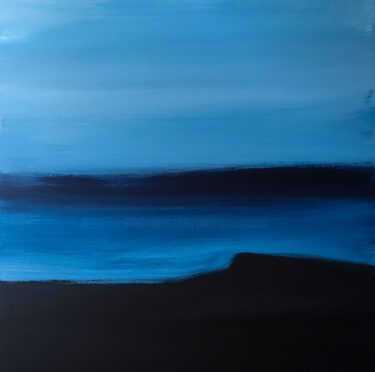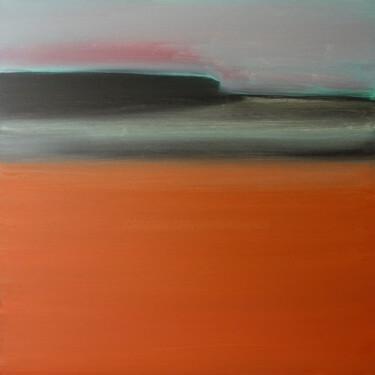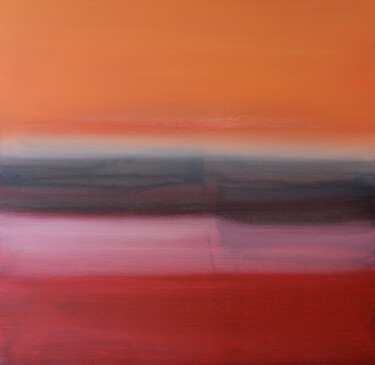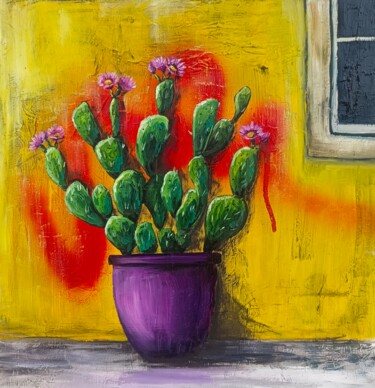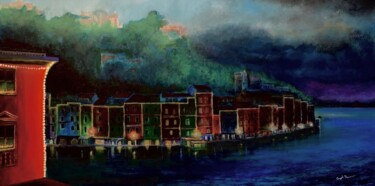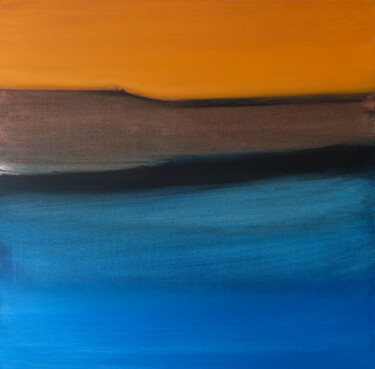587 원본 삽화, 한정판 및 판화:
땅의 예술이라고도 알려진 대지 예술은 풍경을 조각하거나 거기에 자연 재료 구조를 구축하여 풍경에서 직접 만들어집니다. 환경 운동의 시작과 1960년대 후반 미국 미술의 광범위한 상품화는 다양한 정도로 미술 시장에서 소외된 아이디어와 작품에 영향을 미쳤습니다. 운동은 개념주의와 미니멀리즘의 발전이었습니다.
예술운동의 주요 관심사는 예술의 상업화에 대한 반대와 새롭게 떠오르는 생태운동에 대한 열정이었다. 반도시 정서의 만연과 전원 생활에 대한 상쇄 열정은 예술 운동과 일치했습니다. 지구가 인류의 집이 되기를 바라는 영적 열망이 이러한 충동 중 하나였습니다.
예술가가 주변 환경으로 여행을 떠나 물건을 수집하거나 장소 특정적 개입을 수행하는 예술 창작의 과정 기반 방법은 처음에 흙, 바위와 같은 자연 재료를 통합하는 조각의 경향으로 시작된 것에서 빠르게 발전했습니다. , 그리고 식물. 일부 예술가는 풍경에 일시적이고 제한적인 개입을 하는 반면 다른 예술가는 기계 토공 장비를 사용하여 토공사를 만들었습니다. 갤러리에서 프리젠테이션을 위해 예술가들은 종종 사진, 필름 및 지도를 사용하여 토공사를 기록했습니다. 또한 환경의 유기적 요소를 조각과 설치물에 결합함으로써 대지 예술가들은 갤러리에서 대지 예술을 창조했습니다.
랜드아트의 역사
대지 예술은 1960년대와 1970년대에 걸쳐 미국 예술의 "무자비한 상업화"에 대한 항의였습니다. 그러나 기존의 갤러리 공간에는 사진 문서가 자주 전시되었습니다. 이 기간 동안 대지 예술 지지자들은 예술 활동을 위한 장소로서의 박물관이나 갤러리를 거부하고 전통적인 운송 가능한 조각과 상업 예술 시장의 범위를 벗어난 기념비적인 조경 프로젝트를 만들었습니다. De Stijl, Cubism, Minimalism, Constantin Brâncuși 및 Joseph Beuys의 작품과 같은 현대적 경향뿐만 아니라 미니멀리스트 및 개념 예술은 Land art의 영감을 제공했습니다.
The New York Times의 예술 평론가 Grace Glueck의 기사에 따르면 최초의 대지 예술은 1967년 Douglas Leichter와 Richard Saba가 Skowhegan School of Painting and Sculpture에서 제작했습니다. 1968년 대지 예술의 갑작스러운 등장은 대부분 20대 후반이던 한 세대의 예술가들이 급속히 성장하는 환경 및 여성 해방 운동뿐만 아니라 정치적 행동주의의 증가에 대응했기 때문일 수 있습니다.
선구적인 예술가 그룹을 공개적으로 식별하는 수단으로 사용된 대지 예술의 예는 1968년 뉴욕 Dwan Gallery에서 열린 "Earthworks"라는 그룹 쇼였습니다. "Earthworks"는 Sol LeWitt, Robert Morris, Claes Oldenburg, Dennis Oppenheim, Stephen Kaltenbach와 같은 예술가들의 현장 특정 프로젝트 문서를 전시했습니다. 전시회의 일부 예술가들은 현장 특정 작업에 적합한 토지를 찾는 데 어려움을 겪었기 때문입니다. 전시는 지도, 사진, 투명 필름, 그림을 통해 그들의 작업이 어떻게 개념화되었는지 목록화했습니다. 아이러니하게도, 기존의 제도를 거부하려는 이들 예술가들의 노력에도 불구하고 그들은 프로젝트를 개발하기 위해 종종 그들로부터 자금을 받아야 했습니다.
Robert Smithson은 아마도 이 장르에서 작업한 가장 잘 알려진 예술가일 것입니다. 사회 문제에 대한 모더니즘의 이탈에 대한 응답으로 그의 1968년 에세이 "The Sedimentation of the Mind: Earth Projects"는 운동을 위한 중요한 틀을 제공했습니다. Spiral Jetty(1970)는 Smithson이 미국 유타주 북부의 그레이트 솔트레이크에 돌출된 긴(1500피트) 나선형 모양의 부두로 만든 것으로 그의 가장 유명하고 가장 유명한 대지 예술 작품입니다. 눈에 보이는 작업량은 수위 변화에 따라 다릅니다.
Earth Art라는 제목의 Earth Art 전시회를 개최한 최초의 미국 박물관은 1969년 2월 Cornell University의 Herbert F. Johnson Museum of Art였습니다. 작품은 박물관과 Cornell University의 Ithaca 캠퍼스 전체에서 볼 수 있었습니다. , 나중에 상품으로서의 예술의 지위에 계속해서 도전하게 될 작품, 특히 사물의 맥락과 주변 환경 사이의 경계를 모호하게 만드는 설치물을 위한 장소를 제공합니다.
경기 침체는 1970년대 중반 어스 아트 자금 조달에 상당한 영향을 미쳤습니다. 많은 예술가들은 스폰서에게 의존하여 대규모 작업을 완료할 수 있도록 값비싼 토지를 구입했습니다. 이 운동은 1973년 로버트 스미슨이 항공기 추락 사고로 사망했을 때 가장 중요한 인물 중 하나를 잃었고 결국 끝났습니다. De Maria, Heizer, Morris, Andre와 같이 지구 예술에서 명성을 쌓은 사람들은 기관 및 갤러리 환경에 맞추기 위해 작업의 초점을 변경했습니다. 대지 예술 선구자들의 아방가르드 작품과는 개념적으로 관련이 없지만 "대지 예술"이라는 단어는 공공 예술의 주류에 진입했으며 때때로 자연의 모든 형태의 예술을 설명하는 데 오용됩니다.
대지미술 주요작가
로버트 스미스슨(1938-1973)
Robert Smithson의 선구적인 작업은 모든 대지 예술 분석에 포함되어야 합니다. 입체적인 조각적 구성을 만들기 위해 다양한 재료를 조합하기 시작했다. 이것은 원정에서 가져온 흙과 바위로 만든 조각품을 갤러리 내부에 배치하는 일련의 "비 사이트"작업으로 이어졌습니다. 이 조각품에는 지도, 상자, 거울, 유리, 네온 등이 자주 포함되었습니다. Smithson의 토공사 Spiral Jetty(1970), Broken Circle/Spiral Hill(1971) 및 Amarillo Ramp(1973)는 그의 가장 유명한 작품(1973)입니다. 갤러리 맥락에서 예술을 완전히 제거하고 자연 지형에 통합함으로써 그는 현대 미술에서 조각 형식에 대한 선입견을 영원히 바꾸었습니다.
앤디 골드워시(1956년생)
Andy Goldsworthy는 자연과 함께 작업하는 유명한 대지 예술 조각가이자 사진작가입니다. 그의 산출물은 영구 프로젝트와 임시 프로젝트로 분류할 수 있습니다. 후자는 수명 주기가 끝나면 사라지도록 설계되었으며 유기적이고 일시적인 구성 요소로 구성됩니다. 그는 나뭇가지, 잎사귀, 바위, 얼음으로 나선형, 원, 구불구불한 선을 포함하여 여러 가지 반복적인 디자인을 만듭니다. 이러한 이니셔티브의 중심에 있는 덧없음은 연약한 생태계와 지속적으로 변화하는 자연 환경을 반영합니다.
낸시 홀트(1938-2014)
그녀의 유명한 남편인 로버트 스미스슨(Robert Smithson)에 가려졌음에도 불구하고 홀트는 자신의 작품과는 다른 독특한 작품을 만들었고 더 미래적인 느낌을 가졌습니다. Holt의 최고의 작업 중 일부는 흔적 남기지 않는 전략을 사용할 때 거의 존재하지 않습니다. Holt는 다른 Land Artists보다 더 일찍 그리고 더 명확하게 예술과 환경 운동 사이의 연관성을 인식했습니다.
마야 린(1959년생)
가장 잘 알려진 명소 중 하나는 워싱턴 DC의 Maya Lin이 설계한 베트남 참전용사 기념관입니다. 그녀의 시그니처는 주변 지형의 윤곽을 따라 단순하고 낮은 벽을 사용하는 것입니다. 공공 예술에 대한 그녀의 미니멀리스트 접근 방식은 나중에 추가된 것처럼 보이지만 그럼에도 불구하고 어울리는 것을 추가하는 것을 수반합니다.
그녀의 야외 설치물은 아주 높은 곳이나 먼 거리에서 바라보지 않으면 눈에 띄지 않을 수 있는 작은, 거의 인지할 수 없는 흙의 팽창을 특징으로 합니다. 그녀의 최근 관심은 지적이고 시각적으로 멀리 떨어진 지리적 영역의 구불구불한 지형을 불러일으키고 내포된 환경적 관심을 보존하는 실내 조각품에 있었습니다.
아나 멘디에타(1948-1985)
특히 인간의 몸이 자연과 상호작용하고 자연으로 돌아가는 방식에 있어 랜드 아트의 발전에 영향을 미친 인물은 쿠바의 페미니스트 예술가 아나 멘디에타(Ana Mendieta)였습니다. Mendieta는 그녀의 도발적인 조각을 위한 매체로 그녀의 몸과 지구를 사용하여 200개 이상의 작품을 제작했습니다. 그녀의 작업은 다층적이고 깊이 철학적이며 개념주의, 대지 예술, 퍼포먼스 및 바디 아트를 포함한 다양한 예술 전통과 관련이 있습니다. Mendieta는 사진 및 비디오 시리즈 Silueta(1973–1980)를 통해 지구 예술의 선구자로 자리 잡았습니다. 행성과 인간 본성 사이의 끊을 수 없는 유대를 보여주기 위해 작가는 프로젝트를 위해 자신의 몸을 여러 풍경으로 조각했습니다.
월터 드 마리아(1935-2013)
그의 조각, 설치 및 토지 작업에서 Walter de Maria는 상대적인 것과 절대적인 것 사이의 연결을 탐구하는 일련의 반복을 생성하기 위해 기하학적 형태를 사용했습니다. 그의 가장 잘 알려진 대지 예술 작품인 조명 필드(Lighting Field, 1977)는 뉴멕시코 사막의 오지에 놓인 1마일 x 1킬로미터 정사각형의 그리드입니다. 높이가 20피트 이상이고 끝이 뾰족하여 번개가 치는 지점인 수평면을 정의하는 뾰족한 끝이 있는 광택이 나는 스테인리스 스틸로 만든 400개의 기둥이 그리드를 구성합니다. 시간과 공간, 예술, 풍경, 자연이 충돌하는 일련의 강력한 착시 현상 속에서 방문객은 물리적으로 그리드에 들어가거나 멀리서 관찰할 수 있습니다.
마이클 하이저(1944년생)
Michael Heizer는 대지 예술 운동에서 중요한 인물이었습니다. 그는 대규모 작업을 구성하고 긍정적인 공간과 부정적인 공간 사이의 상호 작용을 탐구하는 능력으로 유명합니다. 그는 "네거티브 페인팅(negative painting)"이라고 불렀던 일련의 곡선 캔버스로 예술 경력을 시작했습니다. 1960년대 후반에 그는 "동서남북"이라는 첫 번째 네거티브 랜드 피스를 만들었습니다. 이 프로젝트는 대규모 토공에 대한 그의 첫 번째 시도였으며 시에라 네바다 사막에서 파낸 기하학적 모양의 구멍 모음으로 만들어졌습니다.
리차드 롱(1945년생)
1960년대 후반, 작가는 풍경을 새로운 방식으로 사용하고자 하는 열망에서 산책을 매개로 자연과의 직접적인 교감을 시작하였다. 반복적인 제스처의 연속이나 장기간의 단독 보행을 통해 오랫동안 예술의 언어와 열망을 전복시키고 보다 기본적이고 친밀하며 근본적인 수준으로 가져오려고 시도했습니다. 그의 목표는 인간과 환경 사이의 순수한 대화의 가능성을 스스로 예증하는 것이 었습니다. 시간, 공간, 거리를 주제로 한 이 획기적인 개념적 대지미술 프로젝트는 거대한 규모로 확장된다.
데니스 오펜하임(1938-2011)
Michael Heizer, Nancy Holt, Walter De Maria, Robert Smithson 및 Oppenheim과 함께 Land 아티스트의 1세대에는 Oppenheim이 포함됩니다. 1960년대에 그들은 지구 자체를 매체로 사용하여 이 새로운 장르의 예술을 창조했습니다. 자연 세계에 대한 오펜하임의 초기 개입은 그의 동시대인들의 것과는 대조적으로 제거의 형태를 취했으며, 예술가 자신의 말을 빌리자면 "추가하기보다는 제거"하는 전통적인 조각 원칙으로 되돌아갑니다. 지정학적 경계, 시간대, 자연적 퇴화는 지역 특정 작업인 Annual Rings(1968)에서 참조하고 강조하는 사회적 자연 시스템의 몇 가지 예에 불과합니다. 지도를 재현하는 것은 지도가 주 사이에 부자연스럽고 자주 폭력적인 경계를 만드는 데 어떤 역할을 하는지 보여주고 자연 경계인 강은 이러한 국제 경계를 위한 도구 역할을 합니다.
오펜하임은 국가 및 시간대와 같은 인위적인 아이디어와 자연 요소를 병치하여 "우리가 살고 있는 질서 체계의 상대적 가치"에 의문을 제기했습니다. 동시에 로버트 스미스슨(Robert Smithson)과 월터 드 마리아(Walter de Maria)와 같은 지구 예술가들은 자연 환경이 인공 개입과 충돌하는 장소 특정적 지구 작업도 제작했습니다.
랜드 아티스트 인용문
로버트 스미스슨
"광물의 이름과 광물 자체는 서로 다르지 않습니다. 왜냐하면 재료와 인쇄물의 바닥에는 무수히 많은 균열의 시작이 있기 때문입니다. 단어와 암석에는 분할 및 어떤 단어든 충분히 길게 보면 일련의 결점, 각각 고유한 공허함을 포함하는 입자의 영역으로 열리는 것을 볼 수 있습니다.”
앤디 골드워시
“저는 퍼포머는 아니지만 가끔 공개적인 맥락에서 의도적으로 작업합니다. 일부 조각품은 주변 사람들의 움직임이 필요합니다.”
"겨울에도 한적한 눈밭은 특별한 성질을 가지고 있습니다."
낸시 홀트
"당신은 이 광활한 공간의 작은 알갱이일 뿐입니다."
마야 린
“예술은 자신을 위해 하는 것이기 때문에 매우 까다롭습니다. 기념물이나 건축물보다 그런 작품을 만드는 것이 훨씬 더 어렵습니다. ”
아나 멘디에타
"나의 예술은 곤충에서 인간으로, 인간에서 유령으로, 유령에서 식물로, 식물에서 은하계로 모든 것을 관통하는 하나의 보편적인 에너지에 대한 믿음에 기반을 두고 있습니다. 내 작품은 이 보편적인 유체의 관개 정맥입니다. 그것들은 조상의 수액, 원래의 믿음, 원시적 축적물, 세상에 생명을 불어넣는 무의식적인 생각으로 올라갑니다.”
월터 드 마리아
"저는 자연재해를 좋아하고 경험할 수 있는 최고의 예술이 아닐까 생각합니다."
"모든 좋은 작품에는 적어도 열 가지 의미가 있어야 합니다."
마이클 하이저
“강력한 예술 작품은 정말 사람들을 말문이 막히게 합니다. 그들은 그것을 이해하지 못하기 때문에 약간 화를 냅니다.”
리차드 롱
“조각, 지도, 사진; 내 작업의 모든 형태는 동등하고 보완적입니다. 내 행동에 대한 지식은 어떤 형태로든 예술입니다. 내 예술은 내 경험의 본질이지 내 경험의 표현이 아닙니다.”
데니스 오펜하임
“제 작업의 대부분은 아이디어에서 나옵니다. 나는 일반적으로 각 아이디어의 몇 가지 버전만 할 수 있습니다. Land Art와 Body Art는 많은 순열을 허용하는 특히 강력한 개념이었습니다. 그럼에도 불구하고 나는 다른 것으로 나아가고 싶다는 것을 깨달았습니다.”
이탈리아 아티스트 의 작품은 어디에서 구입할 수 있나요?
Artmajeur는 최고의 현대 이탈리아 예술가 : 이탈리아 화가, 이탈리아 조각가, 이탈리아 사진가 를 선택하여 갤러리에서 신진 및 확정 아티스트를 모두 찾을 수 있습니다.
이탈리아 화가, 조각가 및 사진 작가가 가장 인기 있는 매체이지만 콜라주, 디지털 아트 또는 섬유 예술과 같은 다른 매체에서 판매되는 멋진 현대 작품도 있습니다. Artmajeur 갤러리는 이탈리아 에서 매우 인기가 있습니다. 많은 현대 예술가들이 자신의 작품을 판매하는 데 사용하기 때문입니다. 이탈리아 아티스트 의 예술 작품을 구매하려는 수집가는 다양한 기술, 색상, 스타일 및 가격을 찾을 수 있습니다.
Historically, Italy is undoubtedly the country which has allowed Art to acquire an unprecedented dimension in Western spiritual and cultural life. After the horrors of the Middle Ages, it is in fact in Italy where the European cultural renaissance finds its origin and draws its tremendous development. Reconnecting with Greco-Latin influences, the Italian renaissance in the 15th century constitutes a saving renewal in the cultural and artistic world and allowed to propel the Italian artists, painters and sculptors, the most emblematic in the history of Art like Leonardo. by Vinci, Michelangelo, Sandro Botticelli, Raphaël… with their lots of masterpieces still unmatched.
Discover contemporary artworks on Artmajeur
Contemporary art is a vibrant constellation of artistic expressions. This creative universe encompasses a wide array of mediums, from paintings, sculpture, and photography to drawing, printmaking, textile art, and digital art, each medium a star shining with its own distinct radiance. Artists use diverse supports and materials to bring their visions to life, such as canvas, wood, metal, and even innovative digital canvases for the creation of virtual masterpieces.
A contemporary painting, for instance, may weave its story through the masterful strokes of acrylic or oil, while a contemporary sculpture might sing its song in the language of stone, bronze, or found objects. The photographic arts capture and manipulate light to produce striking images, while printmaking employs techniques like lithography and screen-printing to produce multiples of a single, impactful image. Textile art plays with fabrics and fibers, whereas digital art pushes the boundaries of creation with innovative technology.
The allure of contemporary art lies in its boundary-pushing nature, its relentless quest for experimentation and its constant reflection of the evolving human experience. This boundless creativity, coupled with its strong social and personal commentary, makes every piece of contemporary art a unique emblem of its time, a mirror held up to the realities and dreams of our complex world. It whispers to us, moves us, provokes thought, and kindles a deep emotional response, stirring the soul of anyone willing to listen. It is, indeed, the language of emotions and ideas, spoken in the dialect of our era.
 작품, 47.2x43.3 in "
>
작품, 47.2x43.3 in "
>
©2024 Hannes Hofstetter
Origins and history of contemporary art
The story of contemporary art unfolds in the mid-20th century, marked by seismic shifts in artistic expression. Post-World War II, around the 1950s and 1960s, artists began experimenting beyond traditional confines, challenging the norms of what art could be. This revolutionary epoch birthed myriad new movements and artistic forms such as abstract expressionism, pop art, and minimalism. Paintings, once confined by realism, embraced abstraction, as artists used color and form to express emotions and ideas. Notable periods like the advent of pop art in the late 1950s and early 1960s saw artworks mimicking popular culture and mass media, reflecting society’s shifting focus.
The sculptural arts, too, witnessed a metamorphosis. Sculptors started to experiment with new materials and forms, often creating artworks that interacted with the viewer and the surrounding space, fostering a sense of engagement. Drawing, a timeless practice, also evolved, with artists incorporating innovative techniques and concepts to redefine its role in contemporary art.
Photography, a relatively new medium, emerged as a powerful tool in the contemporary art landscape. Born in the 19th century, it truly came into its own in the latter half of the 20th century, blurring the lines between fine art and documentation. Printmaking, a practice dating back to ancient times, saw renewed interest and experimentation with techniques like lithography, etching, and screen printing gaining prominence.
The realm of textile art expanded dramatically, as artists began to appreciate the versatility and tactile quality of fabric and fibers. Artists began using textiles to challenge the boundaries between fine art, craft, and design.
The dawn of digital technology in the late 20th century heralded a new age for contemporary art. Digital art emerged as artists started leveraging new technologies to create immersive, interactive experiences, often blurring the line between the virtual and the physical world.
Through these transformative periods, the essence of contemporary art has remained the same: a dynamic, evolving reflection of the times we live in, continually pushing boundaries and embracing the new, always questioning, always exploring.

©2018 Maria Lacinque Koine Arte & Comunicazione srl이(가) 대표하는 아티스트
Evolutions of theses contemporary works in the art market
As we navigate through the 21st century, the dynamic landscape of contemporary art continues to evolve and expand, reflecting our ever-changing world. Contemporary paintings, once primarily confined to two-dimensional canvases, now embrace a multitude of forms and techniques, ranging from mixed media installations to digital creations, each piece a rich a weaving of thoughts, emotions, and narratives. Sculpture, too, has ventured far beyond traditional stone and bronze, with artists incorporating light, sound, and even motion, embodying the ephemerality and flux of the modern world.
Photography, in the hands of contemporary artists, has expanded its horizons, seamlessly blending with digital technology to create breathtaking imagery that challenges our perception of reality. Drawing, as well, has transcended the borders of paper, incorporating multimedia elements and exploratory techniques to redefine its role in the artistic discourse. Printmaking continues to flourish, with contemporary artists using traditional methods in innovative ways to deliver potent social and personal commentaries.
Textile art, once considered a craft, now holds a prominent place in the contemporary art world, with artists using it to explore issues of identity, tradition, and cultural heritage. Meanwhile, digital art, the newest member of the contemporary art family, has revolutionized the way we create and interact with art, presenting immersive experiences that blur the boundary between the virtual and the physical.
These diverse forms of contemporary art hold significant value in the current art market, not only due to their aesthetic appeal but also their ability to encapsulate and communicate complex ideas and emotions. Collectors, curators, and art lovers worldwide seek these works, drawn to their inherent dynamism, their innovative use of materials, and their eloquent expressions of our shared human experience. As a testimonial to our times, these contemporary artworks encapsulate the pulse of our society and the resonance of individual voices, forever etching our collective narrative into the annals of art history.

©2016 Antar
Famous Contemporary Artists
As we delve into the vibrant realm of contemporary art, we encounter an array of artists who shape this dynamic field. Each a master in their medium - painting, sculpture, photography, drawing, printmaking, textile, or digital art - they push artistic boundaries, reflecting our era and challenging perceptions. Let’s explore these remarkable contributors and their groundbreaking works.
1. Gerhard Richter - Known for his multi-faceted approach to painting, Richter challenges the boundaries of the medium, masterfully oscillating between abstract and photorealistic styles. His works, whether featuring squeegee-pulled pigments or blurred photographic images, engage in a fascinating dialogue with perception.
2. Jeff Koons - A significant figure in contemporary sculpture, Koons crafts monumental pieces that explore themes of consumerism, taste, and popular culture. His iconic balloon animals, constructed in mirror-polished stainless steel, captivate with their playful yet profound commentary.
3. Cindy Sherman - An acclaimed photographer, Sherman uses her lens to explore identity and societal roles, particularly of women. Renowned for her conceptual self-portraits, she assumes myriad characters, pushing the boundaries of photography as a medium of artistic expression.
4. David Hockney - Hockney, with his prolific output spanning six decades, is a pivotal figure in contemporary drawing. His bold use of color and playful exploration of perspective convey an intoxicating sense of joy and an unabashed celebration of life.
5. Kiki Smith - An innovative printmaker, Smith’s work explores the human condition, particularly the female body and its social and cultural connotations. Her etchings and lithographs speak to universal experiences of life, death, and transformation.
6. El Anatsui - A master of textile art, Anatsui creates stunning tapestry-like installations from discarded bottle caps and aluminum scraps. These shimmering, flexible sculptures blend traditional African aesthetic with contemporary art sensibilities, speaking to themes of consumption, waste, and the interconnectedness of our world.
7. Rafael Lozano-Hemmer - A leading figure in digital art, Lozano-Hemmer utilizes technology to create interactive installations that blend architecture and performance art. His work, often participatory in nature, explores themes of surveillance, privacy, and the relationship between people and their environments.

©2024 Pier Maurizio Greco
Notable contemporary artworks
The contemporary art landscape is a dynamic patchwork of diverse expressions and groundbreaking ideas, each artwork a unique dialog with its audience. Here are a selection of some renowned contemporary artworks, spanning various media such as painting, sculpture, photography, drawing, printmaking, textile art, and digital art, that have profoundly influenced this vibrant movement.
"Cloud Gate" by Anish Kapoor, 2006 - This monumental stainless steel sculpture, also known as "The Bean," mirrors and distorts the Chicago skyline and onlookers in its seamless, liquid-like surface, creating an interactive experience that blurs the line between the artwork and the viewer.
"Marilyn Diptych" by Andy Warhol, 1962 - An iconic piece of pop art, this silkscreen painting features fifty images of Marilyn Monroe. Half brightly colored, half in black and white, it reflects the dichotomy of celebrity life and its influence on popular culture.
"Rhein II" by Andreas Gursky, 1999 - This photographic artwork, a digitally-altered image of the Rhine River, is celebrated for its minimalist aesthetic. It strips the landscape to its bare essentials, invoking a sense of tranquility and vastness.
"Black Square" by Kazimir Malevich, 1915 - A revolutionary painting in the realm of abstract art, this piece, featuring nothing more than a black square on a white field, challenges traditional notions of representation, symbolizing a new era in artistic expression.
"Puppy" by Jeff Koons, 1992 - This giant sculpture, a West Highland Terrier blanketed in flowering plants, explores themes of innocence, consumer culture, and the interplay between high art and kitsch. It’s a delightful blend of traditional sculpture and garden craft.
"Re-projection: Hoerengracht" by Ed and Nancy Kienholz, 1983-1988 - A room-sized tableau representing Amsterdam’s red-light district, this work combines elements of sculpture, painting, lighting, and found objects. It engages viewers in a stark commentary on commodification and objectification.
"Untitled" (Your body is a battleground) by Barbara Kruger, 1989 - This photomontage, combining black-and-white photography with impactful text, explores issues of feminism, identity, and power. Its potent, confrontational message is a prime example of the power of text in contemporary visual art.
"For the Love of God" by Damien Hirst, 2007 - This sculpture, a platinum cast of a human skull encrusted with 8,601 diamonds, probes themes of mortality, value, and the human fascination with luxury and decadence. It’s a compelling blend of macabre and magnificence.
"Physical impossibility of Death in the Mind of Someone Living" by Damien Hirst, 1991 - This artwork, featuring a tiger shark preserved in formaldehyde, blurs the line between traditional sculpture and biological specimen. It prompts viewers to contemplate mortality and nature’s ferocity.
"One and Three Chairs" by Joseph Kosuth, 1965 - A piece of conceptual art, it presents a physical chair, a photograph of a chair, and a dictionary definition of a chair, thus exploring the relationship between language, picture, and referent in art.
These pieces, in their diversity, exemplify the rich tapestry of contemporary art, each piece a unique commentary on our world and a testament to the limitless potential of creative expression.

Maria Lacinque
나무의 콜라주 | 30.3x21.7 in

Mario Giacomelli
사진 | 11.8x15.8 in

Mario Giacomelli
사진 | 15.8x11.8 in

Mario Giacomelli
사진 | 11.8x15.8 in

Ilesh
사진 | 15.8x23.6 in

Vanessa Olandese
사진 | 8.2x13 in






